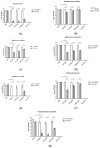In Vitro Eradication of Planktonic, Saliva and Biofilm Bacteria Using Lingonberry Extract as a Photosensitizer for Visible Light Plus Water-Filtered Infrared-A Irradiation
- PMID: 38068846
- PMCID: PMC10708215
- DOI: 10.3390/nu15234988
In Vitro Eradication of Planktonic, Saliva and Biofilm Bacteria Using Lingonberry Extract as a Photosensitizer for Visible Light Plus Water-Filtered Infrared-A Irradiation
Abstract
Antimicrobial photodynamic treatment (aPDT) with visible light plus water-filtered infrared-A irradiation (VIS-wIRA) and natural single- or multi-component photosensitizers (PSs) was shown to have potent antimicrobial activity. The aim of this study was to obtain information on the antimicrobial effects of aPDT-VIS-wIRA with lingonberry extract (LE) against bacteria that play a role in oral health. Planktonic bacterial cultures of the Gram-positive E. faecalis T9, S. mutans DSM20523, S. oralis ATCC 35037 and S. sobrinus PSM 203513, the Gram-negative N. oralis 14F2 FG-15-7B, F. nucleatum ATCC 25586, and V. parvula DSM, the anaerobic F. nucleatum ATCC 25586 and V. parvula DSM 2008, and the total mixed bacteria from pooled saliva and supra- and subgingival plaques of volunteers were all treated and compared. aPDT-VIS-wIRA with LE as PS significantly (p < 0.008) reduced the growth of all tested Gram-positive, Gram-negative, as well as aerobic and anaerobic bacterial strains, whereas without irradiation no reductions were seen (p < 0.0001). NaCl, with or without irradiation, was ineffective. After treatment with CHX 0.2%, the highest killing rate (100%) was observed, and no bacteria (0 log10 CFU) were cultivable. The method also significantly reduced all of the bacteria present in saliva and in the gingival biofilms. Three-dimensional visualization of viable and non-viable microorganisms revealed that LE penetrated deeper into the cell wall layers than CHX 0.2%. LE was an appropriate PS for eradicating microorganisms with VIS-wIRA, either in their planktonic form or in saliva and gingival plaque biofilms. These results encourage further investigation in order to determine which LE compounds contribute to the photosensitizing effect and to evaluate the size of the effect on maintaining oral health.
Keywords: Vaccinium vitis-idea; antimicrobial photodynamic treatment; lingonberry; oral pathogenic bacteria; photosensitizer; visible light plus water-filtered infrared-A irradiation.
Conflict of interest statement
The authors declare no conflict of interest. The funders had no role in the design of the study; in the collection, analyses, or interpretation of data; in the writing of the manuscript; or in the decision to publish the results.
Figures





References
-
- Karygianni L., Ruf S., Follo M., Hellwig E., Bucher M., Anderson A.C., Vach K., Al-Ahmad A. Novel Broad-Spectrum Antimicrobial Photoinactivation of In Situ Oral Biofilms by Visible Light plus Water-Filtered Infrared A. Appl. Environ. Microbiol. 2014;80:7324–7336. doi: 10.1128/AEM.02490-14. - DOI - PMC - PubMed
-
- Al-Ahmad A., Bucher M., Anderson A.C., Tennert C., Hellwig E., Wittmer A., Vach K., Karygianni L. Antimicrobial Photoinactivation Using Visible Light Plus Water-Filtered Infrared-A (VIS+wIRA) Alters In Situ Oral Biofilms. PLoS ONE. 2015;10:e0132107. doi: 10.1371/journal.pone.0132107. - DOI - PMC - PubMed
-
- Al-Ahmad A., Walankiewicz A., Hellwig E., Follo M., Tennert C., Wittmer A., Karygianni L. Photoinactivation Using Visible Light Plus Water-Filtered Infrared-A (vis+wIRA) and Chlorine E6 (Ce6) Eradicates Planktonic Periodontal Pathogens and Subgingival Biofilms. Front. Microbiol. 2016;7:1900. doi: 10.3389/fmicb.2016.01900. - DOI - PMC - PubMed
MeSH terms
Substances
Grants and funding
LinkOut - more resources
Full Text Sources
Molecular Biology Databases
Miscellaneous

